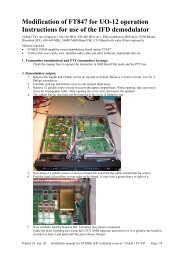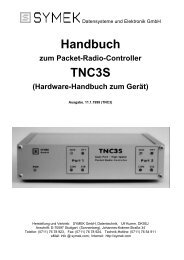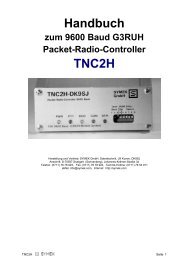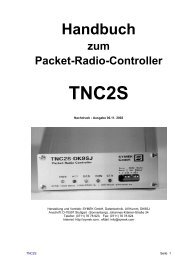Erfolgreiche ePaper selbst erstellen
Machen Sie aus Ihren PDF Publikationen ein blätterbares Flipbook mit unserer einzigartigen Google optimierten e-Paper Software.
4 tx-tail the next byte is the time, the transmitter is keeped keyed upafter the frame transmission is completed. (10 ms steps, 0-127 * 10 ms = 0,01 to max 1.27 s)for values greater then 127 this value is multiplicated by100, i.e. for values of 128 to 255 the txtail time is 1 to max127s. (Inportant for fullduplex digipeaters. As long as thetxtail time is not expired, there is no additional tx-delay.5 full duplex the next byte is 0 for half-duplex, not equal 0 for full-duplex.Default 0.FF return exit KISS-mode.The original idea of a simple protocol for computer / tnc communication was published by Brian Lloyd,WB6RQN. Phil Karn, KA9Q, one of the 'fathers' of the ax.25-protocol, organised the specification and presentedthe first kiss version at 6. August 1986.Source:The KISS TNC: A simple Host-to-TNC communications protocolMike Chepponis, K3MC, Phil Karn, KA9QSMACK - protocol descriptionVersion 1.0, 27. Feb. 91by Jan Schiefer, DL5UE/GØTRR and Dieter Deyke, DK5SG/NØPRA1. introductionIn 1990, amateur-packet-radio-amateurs of area of Stuttgart in Germany thought about the idea to secure thedata transfer between tnc and the WAMPES node controller against transmission errors on the rs232connection. As there have been transmission errors or data loss found on other node controllers, we thoughtabout how to enhance the kiss-protocol by a addtional checksum while remaining compatible with the originalkiss-mode protocol. The result of these reflections was called SMACK (Stuttgarts Modified Amateur-radio-CRC-KISS). This chapter will explain the differences between SMACK and KISS and make it possible to implementSMACK on other systems.2. What is KISS?KISS was proposed by Phil Karn, KA9Q in 1986. [1]. For his TCP/IP-software, he needed a protocol whichmakes it possible to have a simple access to packet-radio below the ax.25 protocol level. KISS offers a level 2aaccess.The remaining tasks of the tnc are mainly to control the channel access (channel-busy recognition, p-persistence-procedure) and the translation of synchronous HDLC-data of the packet-channel to theasynchronous format on the rs232-interface. The KISS-protocol controls the separation of single packets by bydelimiters, the processing of the delimiters which appear in the data stream and defines a simple set ofcommands for setting the tnc parameters. Provisions were made to operate tncs with more than one packetchannels(or modems).3. Modification of the KISS-ProtocolThe host computer communicates in KISS-mode by use of packets. The begin of such a packet is marked by aFEND character as delimiter, followed by a so-called command-byte. This byte defines, whether the packetcontains data or commands (and which command follows). Except the reset-command (255), all commands useonly the lower four bit of the command byte. This makes it possible to use the upper four bytes for the channelnumberfor multi-channel-tnc. So, it is possible to adress 16 channels and set their parameters individually for16 separate channels.As we have never heard about 16- or 8-channel tnc, we used the most significant bit of the command byte foranother purpose. If it is set, the packet is a data-packet containing additional a crc checksum (the crc isgenerated with data packets only). With such packets, the crc checksum is appended at the end of the frame,lower byte first. The following two pictures show the frame format of a data packet without and including thechecksum for different tnc-ports.FEND 0x00 DATA DATA ... DATA FENDKISS-frame without checksum for port 109.11.02 erweitertes <strong>Handbuch</strong> zum TNC Seite 39








